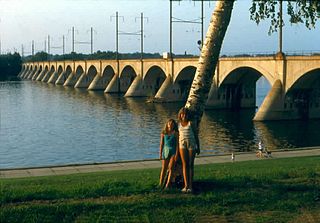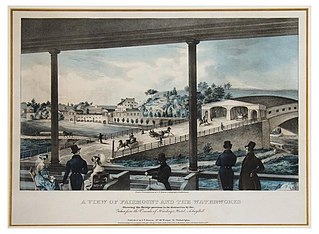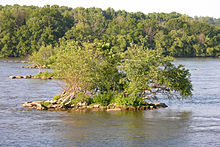
The Hunsecker's Mill Covered Bridge is a covered bridge located in Lancaster County, Pennsylvania, United States. The bridge has a single span, wooden, double Burr arch trusses design. The bridge, which spans the Conestoga River, is 180 feet (55 m) long, making it the longest single span covered bridge in the county.

The Pool Forge Covered Bridge is a covered bridge that spans the Conestoga River in Lancaster County, Pennsylvania, United States. The bridge is now on private property where it was once used as a storage barn before the owner added a road to receive vehicle traffic.

Port Deposit is a town in Cecil County, Maryland, United States. It is located on the east bank of the Susquehanna River near its discharge into the Chesapeake Bay. The population was 653 at the 2010 census.

The Roberto Clemente Bridge, also known as the Sixth Street Bridge, spans the Allegheny River in downtown Pittsburgh, Pennsylvania, United States.

The Columbia–Wrightsville Bridge, officially the Veterans Memorial Bridge, spans the Susquehanna River between Columbia and Wrightsville, Pennsylvania, and carries Pennsylvania Route 462 and BicyclePA Route S. Built originally as the Lancaster-York Intercounty Bridge, construction began in 1929, and the bridge opened September 30, 1930. On November 11, 1980, it was officially dedicated as Veterans Memorial Bridge, though it is still referenced locally as the Columbia–Wrightsville Bridge.

The Coraopolis Bridge is a girder bridge over the back channel of the Ohio River connecting Grand Avenue on Neville Island to Ferree Street in Coraopolis, Pennsylvania. It opened in 1995 to replace a structure of historic significance. The original Pratt/Bowstring/Pennsylvania through truss spans, designed by Theodore Cooper, were formerly the (third) Sixth Street Bridge, spanning the Allegheny River, in downtown Pittsburgh, and were built in 1892 by the Union Bridge Company. They were floated downstream by the Foundation Company in 1927 rather than being demolished when the bridge was removed to enable construction of the present (fourth) Three Sisters (Pittsburgh) Sixth Street Self-anchored suspension bridge. However, by the late 1980s, the old bridge could no longer support traffic volumes and was replaced by a newer structure.

The CSX Susquehanna River Bridge is a railroad bridge that carries CSX's Philadelphia Subdivision across the Susquehanna River between Havre de Grace and Perryville, Maryland, via Garrett Island. It was built in 1907-10 by the Baltimore and Ohio Railroad (B&O) on the same alignment as an 1886 B&O bridge. Like its predecessor, it was the longest continuous bridge on the B&O system.

The Pennsylvania Railroad Bridge once carried the York Branch of the Pennsylvania Railroad across the Susquehanna River between Columbia and Wrightsville, Pennsylvania and is therefore considered a Columbia-Wrightsville Bridge. It and its predecessors were a vital commercial and passenger linkage between Philadelphia and Baltimore for over 100 years.

The Philadelphia & Reading Railroad Bridge carries Norfolk Southern rail lines across the Susquehanna River between Cumberland County, Pennsylvania and Harrisburg, Pennsylvania. Some of its concrete piers encase stone masonry piers from an earlier truss bridge on this site, completed in 1891 by the Philadelphia, Harrisburg and Pittsburgh Railroad, which was then acquired by the Philadelphia and Reading Railroad to connect its Harrisburg and Lurgan lines. The current structure was constructed from 1920 to 1924 by replacing the trusses with concrete arches one track at a time. The bridge has fifty-one concrete arches, three more than the nearby Rockville Bridge.

The Cumberland Valley Railroad Bridge is a currently unused railroad bridge.

Several incarnations of the Conowingo Bridge crossed the Susquehanna River at the original location of Conowingo, Maryland, United States, about two miles upstream of the Conowingo Dam, which replaced it.
Theodore Burr was an inventor from Torrington, Connecticut, who was credited with the Burr Arch Truss bridge design. He designed and built one of the first bridges across the Hudson River and several bridges that crossed the Susquehanna River.

The Burr Arch Truss—or, simply, Burr Truss or Burr Arch—is a combination of an arch and a multiple kingpost truss design. It was invented in 1804 by Theodore Burr, patented on April 3, 1817, and used in bridges, usually covered bridges.

The Market Street Bridge is a stone arch bridge that spans the Susquehanna River between Harrisburg, Pennsylvania, and Wormleysburg, Pennsylvania. The current structure is the third bridge built at its current location and is the second oldest remaining bridge in Harrisburg. The bridge carries BicyclePA Route J across the river.

The Carl E. Stotz Memorial Little League Bridge, formerly known as the Market Street Bridge, carries approximately 27,700 vehicles a day on U.S. Route 15 over the West Branch Susquehanna River between Williamsport and South Williamsport in Lycoming County, Pennsylvania in the United States. It is the seventh bridge on the site and was built at a cost of over $60,000,000.

Louis Wernwag was a prominent bridge builder in the United States in the early 19th century.

The Safe Harbor Bridge also known as the Safe Harbor Trestle, Port Road Bridge and the Enola Low Grade Line Steel Trestle is a steel deck truss trestle that spans the Conestoga River at Safe Harbor, Pennsylvania near the Susquehanna River for the Port Road Branch and the former Columbia and Port Deposit Railroad along the Susquehanna River. It was built in 1905 for the Atglen and Susquehanna Branch (A&S), also known as the "Low Grade Branch", of the Pennsylvania Railroad (PRR).

The Conestoga Creek Viaduct spans the Conestoga River east of Lancaster, Pennsylvania. The present structure, built in 1887–88, is a five-span, two-track stone arch railroad bridge. The first crossing at this location was a 1,412 feet (430 m) series of 11 wooden Town lattice trusses constructed in 1829 for the Columbia and Philadelphia Railroad, which was purchased by the Pennsylvania Railroad (PRR) and incorporated into its main line in 1857. PRR shortened the viaduct and replaced the remaining wooden trusses with iron Whipple trusses in 1863. The 1887-88 stone arch replacement was originally intended to be four tracks wide, but only half of the superstructure width was constructed, leaving an unfinished spandrel wall on the southern face. Tie rods were added in 1930 to brace the spandrel walls.

Meems Bottom Covered Bridge is a covered bridge in Shenandoah County, Virginia, United States. The bridge, at 204 feet (62 m), is the longest covered bridge in Virginia and one of the last that supports regular traffic. Near the town of Mount Jackson, the Meems Bottom Covered Bridge features a 200-foot single-span wooden Burr arch structure. Built in 1892 by Franklin Hiser Wissler, the wooden bridge over the North Fork of the Shenandoah River provided access to his apple orchards at Strathmore Farms. The bridge was listed on the National Register of Historic Places on June 10, 1975.



















